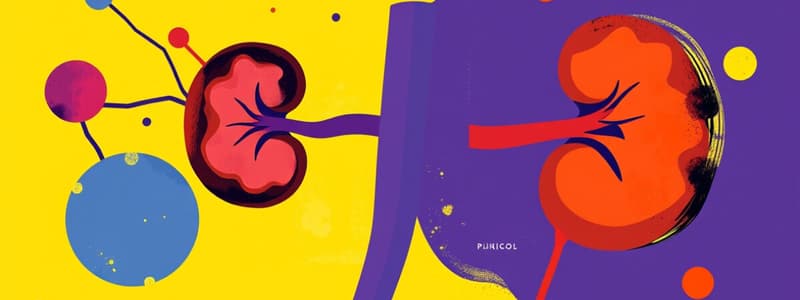Podcast
Questions and Answers
What is a distinct characteristic of loop diuretics compared to other types?
What is a distinct characteristic of loop diuretics compared to other types?
- They cause potassium retention.
- They primarily increase the excretion of NaCl. (correct)
- They act on the proximal convoluted tubule.
- They reabsorb water in the collecting ducts.
What common side effect is associated with thiazide diuretics?
What common side effect is associated with thiazide diuretics?
- Metabolic acidosis
- Hyponatremia (correct)
- Hyperkalemia
- Acute renal failure
What is the primary role of potassium-sparing diuretics?
What is the primary role of potassium-sparing diuretics?
- To increase urinary calcium excretion.
- To prevent potassium loss during diuresis. (correct)
- To promote water reabsorption in the nephron.
- To lower blood pressure through vasodilation.
Which condition is least likely to require the use of diuretics for treatment?
Which condition is least likely to require the use of diuretics for treatment?
What is a potential unwanted effect of diuretics on electrolyte balance?
What is a potential unwanted effect of diuretics on electrolyte balance?
Which of the following is NOT an unwanted effect of loop diuretics?
Which of the following is NOT an unwanted effect of loop diuretics?
Loop diuretics can be particularly useful in treating which of the following conditions?
Loop diuretics can be particularly useful in treating which of the following conditions?
What is the mechanism by which thiazide diuretics primarily function?
What is the mechanism by which thiazide diuretics primarily function?
Which of the following adverse effects is commonly associated with thiazide diuretics?
Which of the following adverse effects is commonly associated with thiazide diuretics?
Which of the following statements about potassium-sparing diuretics is correct?
Which of the following statements about potassium-sparing diuretics is correct?
Flashcards are hidden until you start studying
Study Notes
Kidney Functions
- Maintains homeostasis by eliminating waste products and regulating extracellular fluid (ECF) volume, electrolytes, and pH.
- Receives about 25% of cardiac output; filters approximately 120 liters of blood daily.
- About 99% of filtered water and much sodium are reabsorbed; roughly 1.5 liters is excreted as urine in 24 hours.
Diuretics Overview
- Primary function increases excretion of solutes, mainly NaCl, leading to increased urine volume due to osmotic pressure in renal tubules.
- Often necessary in conditions such as hypertension, congestive heart failure, and renal failure when dietary sodium restriction is insufficient.
Action Mechanisms
- Diuretics can act directly on nephron cells or modify the composition of the filtrate.
Types of Diuretics
- Loop diuretics
- Thiazide diuretics
- Potassium-sparing diuretics
- Osmotic diuretics
Loop Diuretics
- Examples include furosemide and bumetanide.
- Clinical uses: hypertension, congestive heart failure, acute pulmonary edema, renal failure, nephrotic syndrome, hyperkalemia, and chemical intoxication.
- Common side effects: hypovolemia, hypotension, hypokalemia, metabolic alkalosis, hyperuricaemia, and dose-related hearing loss.
Thiazide Diuretics
- Block Na+–Cl− co-transport in the early distal tubule, increasing excretion of sodium, chloride, magnesium, and potassium while promoting calcium absorption.
- Effective orally; co-administration with loop diuretics enhances effects.
- Specific medications include bendroflumethiazide with a peak effect of 4-6 hours and chlortalidone lasting 24-48 hours.
- Side effects include erectile dysfunction, hypokalemia, hyponatremia, and hypomagnesemia.
Mechanisms of Loop Diuretics
- Act on the ascending loop of Henle which contains Na+-K+-2Cl- co-transporter; blocking this increases excretion of these ions and water.
- Promote greater diuresis compared to thiazides and enhance excretion of calcium and magnesium.
Pharmacokinetics of Loop Diuretics
- Administered orally or intravenously; oral onset is about 1 hour, and peak intravenous effect is within 30 minutes; duration is 3-6 hours.
- Strongly bound to plasma proteins and are secreted into the tubular lumen, reflecting their classification as potentially toxic substances.
Renal Physiological Effects
- Loop diuretics lead to a loss of chloride, increasing plasma bicarbonate concentration, resulting in a form of metabolic alkalosis termed 'contraction alkalosis'.
Studying That Suits You
Use AI to generate personalized quizzes and flashcards to suit your learning preferences.




